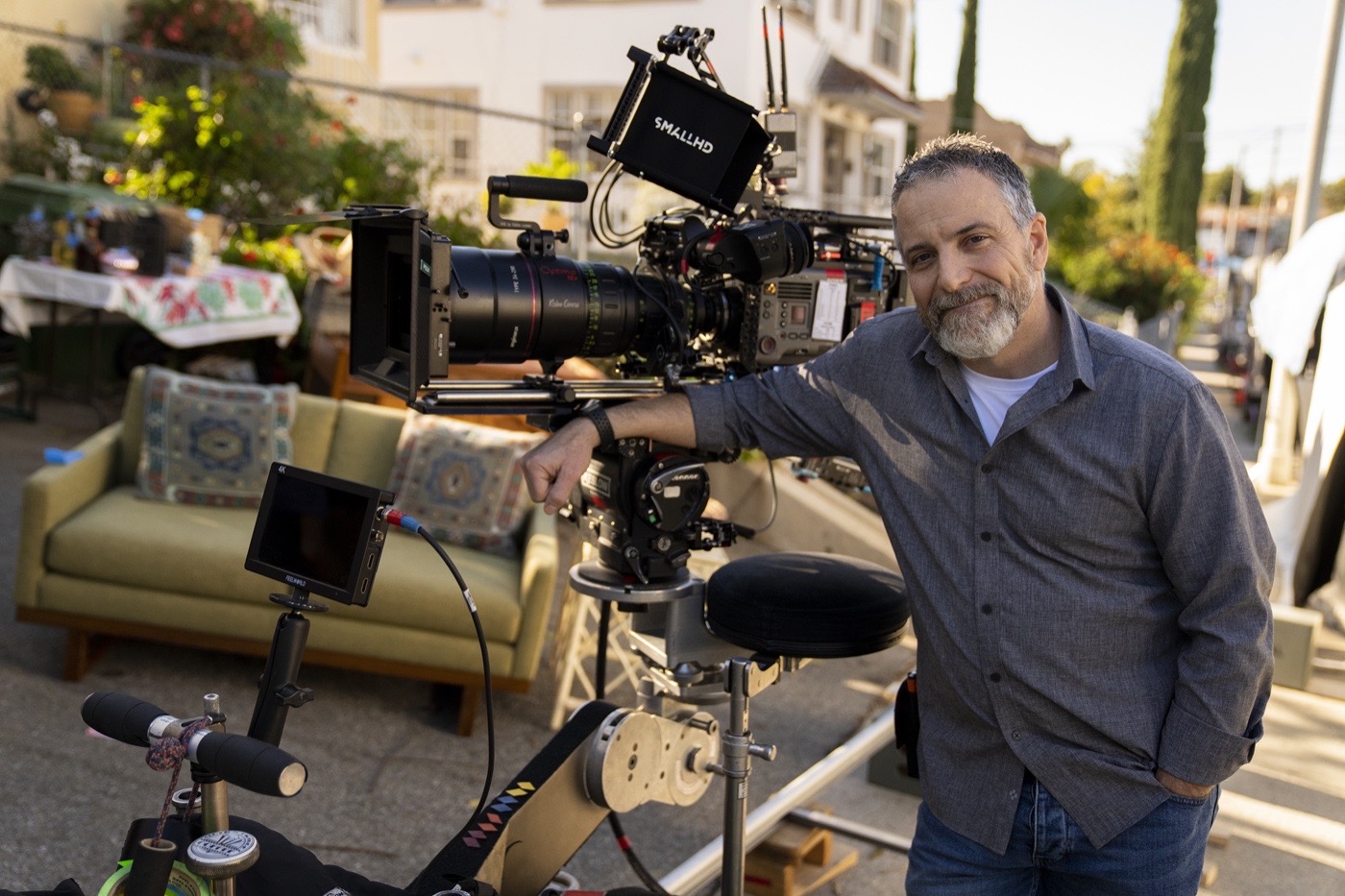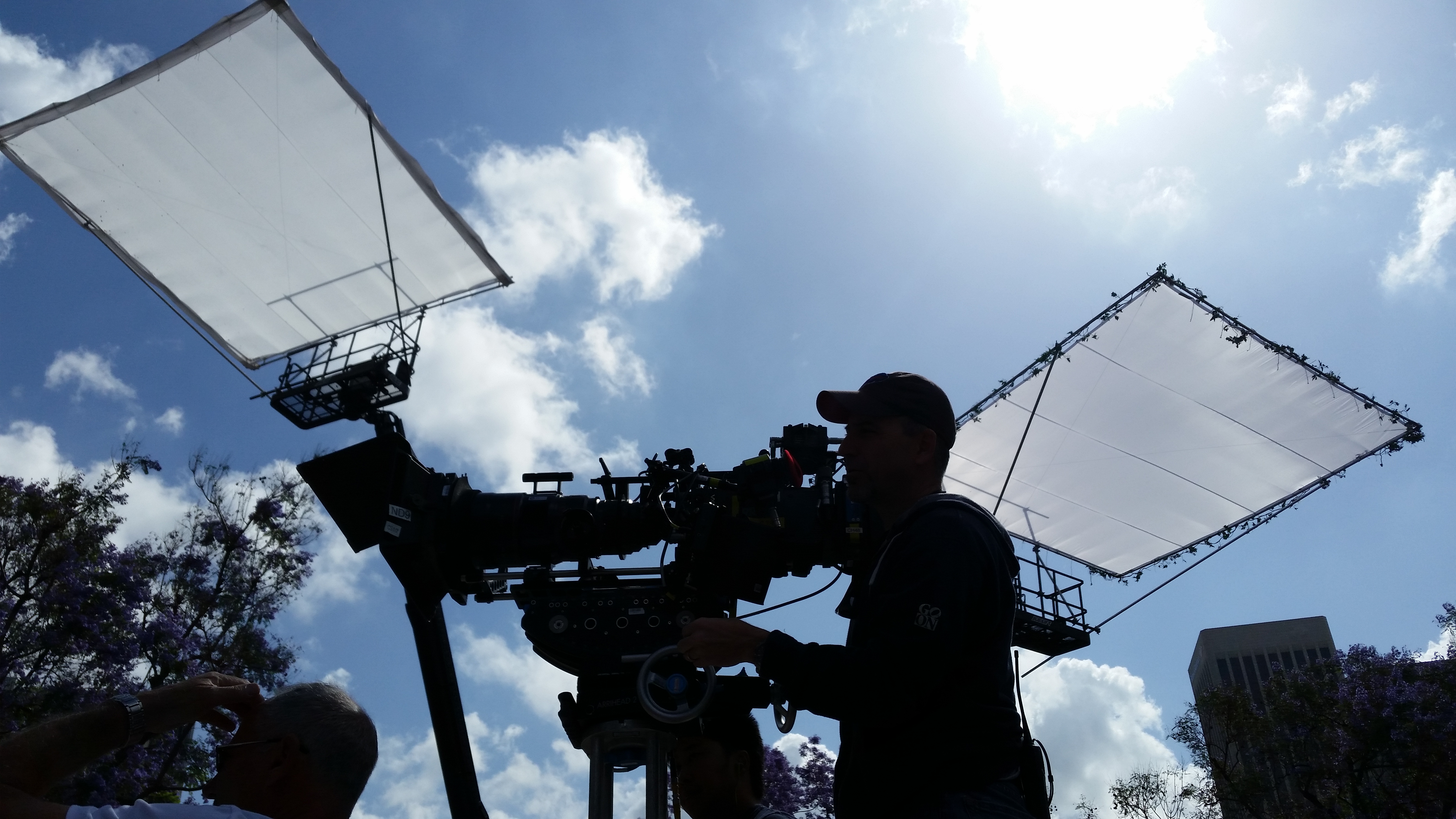Rick Page is a Director of Photography for television and film and is known for Brooklyn Nine-Nine (NBC, Emmy & Golden Globe), The Sex Lives of College Girls (HBOmax), Grand Crew (NBC), Blockbuster (Netflix), and the award-winning An Uncandid Portrait (2021, Tribeca Film Festival). Starting 30 years ago as a camera assistant, Rick’s extensive career spans television, features, commercials, IMAX, music videos, documentaries, and web series.
As a member of both the International Cinematographers Guild and the Directors Guild of America (DGA), his films have won numerous awards including Best Cinematography, Best Director, Best Screenplay, Best Actor, and Best Short. In 2002, his film Water With Food Coloring was shown in limited theatrical release. He's also earned several Tellys, CINE Golden Eagle and Golden Aurora awards for directing. In 2014, Rick co-created the web series Made Right Here with fellow U of U film alumnus, Matt Springer ’94, produced in partnership with Maxwell House Coffee. Rick shot, directed, and co-produced the 10-part series.
Feature credits include (assisting & operating) The Incredible Burt Wonderstone, Grudge Match, Harold & Kumar 3D Christmas, Legally Blonde 2, This Is It, and High School Musical 3. Network TV includes Benched, Up All Night, Go On, A Lyon in the Kitchen, Promised Land and Touched By An Angel, as well as numerous pilots and mini-series.
After growing up in Buffalo, NY, Rick started making films in high school in Columbia, MD and later graduated with a BA in Film Studies from the University of Utah, earning scholarships and awards for his student films. Concurrently, he learned lighting, camera operating and directing while working at the PBS affiliate, KUED in Salt Lake City. 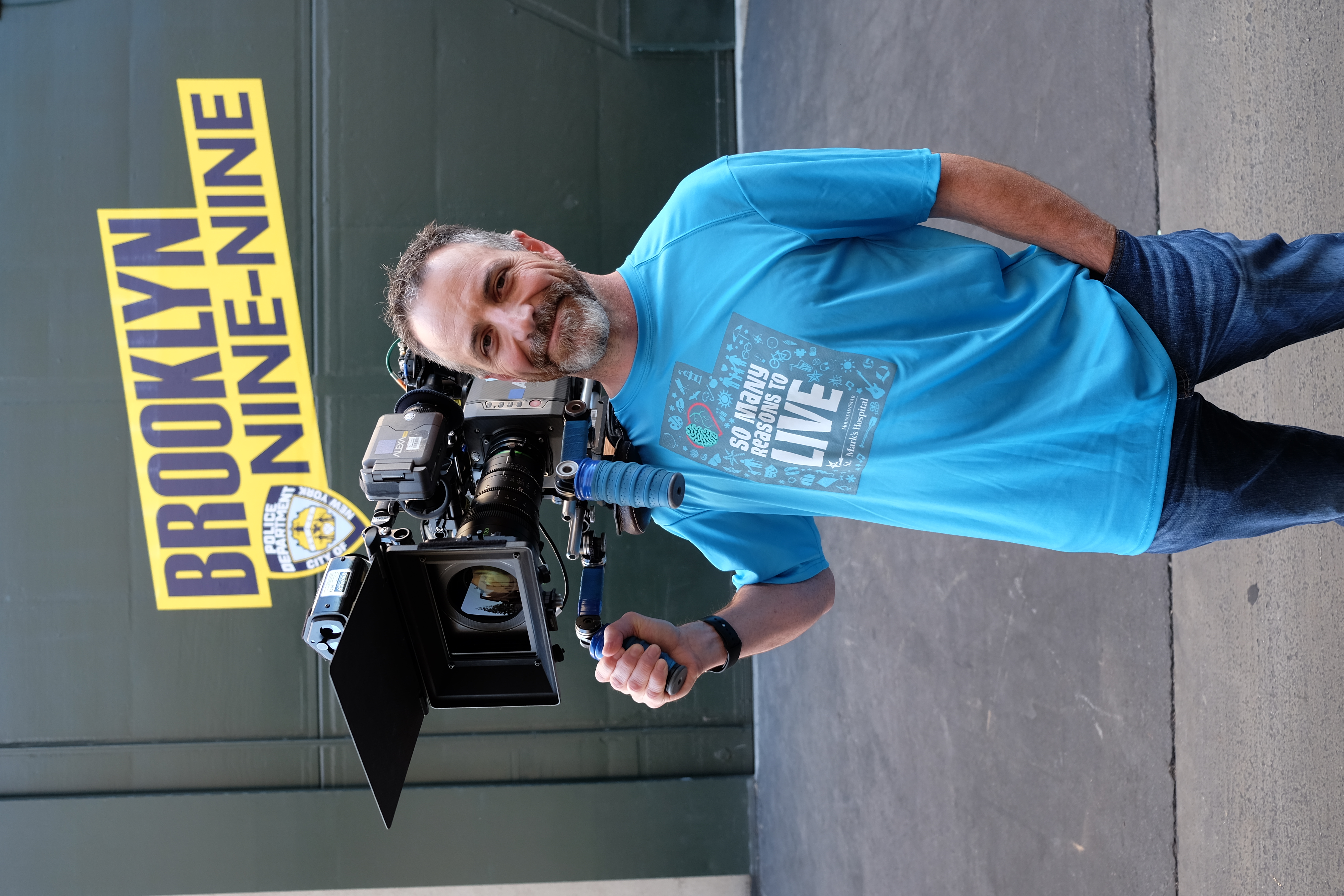 Brooklyn Nine-Nine / NBC Universal
Brooklyn Nine-Nine / NBC Universal
What sparked your early interest in films?
The first impression a film ever made on me was in 1978, it was Richard Donner’s Superman with Christopher Reeve. I grew up in a very small town called Lockport, just north of Buffalo, New York. One Saturday when I was six, my dad took me to the movies. I can remember watching it for the first time and being blown away. I asked him “How is he flying?” He said, “Well, he’s got the red cape.” I said “No, no, but how are they making him fly?” I knew, even at six, that there was a magic trick and I wanted to be in on it. Very early on I caught the bug of wanting to understand the craft behind filmmaking.
Later on, 11, 12 years old, I got into collecting and drawing my own comic books. I’d sell them at school for a quarter. Visual storytelling at its purest.
In 6th grade we had this photography class. We were taught how to shoot film with these pretty basic cameras, then develop it, and print in a dark room. That excited me. Getting images to come to life was magic, especially at that age. And my dad was a photography hobbyist. He loved taking his cameras out and shooting photos with my brother and me, so I think there was some unconscious influence there.
When I got to high school, filmmaking came knocking on the door again. We had moved to Maryland and I joined the track team. I wanted to be included, be a part of something. I ate lunch every day with these four guys from the team who became my buddies. They were all in AP classes. I was not an amazing student. I was more right-brained. I gravitated to History and English (subjects with stories), drama club –– I’d done a handful of plays. The guys were doing this AP English project and wanted to make a little movie. They asked me to run the VHS camcorder. I was the only one who really knew how to work the camera. So we made this short little detective film, very tongue-n-cheek à la Batman and Robin, and cut it together using two VCRs. This was long before computer/digital editing. I remember thinking: why couldn’t we cut our project together by hooking up two VCRs, playing a tape in one, hitting record on the other, then pause the recording, fast forward to another shot, and then un-pause? Then we could use the left channel of audio via RCA cable, and play a cassette for music…boom, editing.
We stumbled onto something big. We had our own little edit bay in our buddy’s basement.
We showed it to the class. That was the spark. The reaction we got from our classmates, our teacher – wondering how we did this – the time we’d spent, the energy, the creativity – it was everything to me. I discovered that all I wanted to do was make films.
What happened next? How did you end up at the University of Utah?
After my friends and I graduated, we decided to make the sequel as a feature length film. We made it with no money – just running all over town throughout the summer, filming at places we worked, casting our friends, family and co-workers as the characters. It was liberating. Then I got a job teaching part-time at a camp and made a promotional video for them. I was doing everything I could to prepare myself for this unknown future. In the fall, I was set to attend UMBC (University of Maryland, Baltimore County). College Park (University of Maryland, College Park) had a small film program that was fizzling out, UMBC had nothing. But I didn’t have the resources to go out of state and I knew I needed to get started somewhere.
So, I started going to UMBC while my track friends went away to colleges out of state. I felt stuck. I just wanted to make films. I didn’t have great SAT scores but I did have a high GPA, and I was doing well at UMBC. I stumbled upon the U and thought, well, it seemed close to California, and I wanted to check out what they had for a film program. I flew out to visit and fell in love with the film department. Something there really spoke to me, inspired me, and I just felt like this was my destination. The canvas was calling me to paint.
I went back to Maryland, took a hiatus from school, and worked for 9 months, balancing six different jobs at 90 hours a week in order to save enough money to get out west. In September of ’91, I boarded a train for $239. I had my duffel bag from track and two footlockers, and I moved all my hopes and dreams out to Utah. I was 19. Got off the train and never looked back.
Once on campus, I found out there was a theatre in the Residence Halls (in Ballif Hall) that screened movies every weekend, and I asked them if they would show my feature. That created a bit of buzz. Seeing it projected on the big screen was something else. Then I talked to the head of the film department at the time, Bill Siska. He said the movie was great, admired my tenacity, but there were no open spots (scholarship-wise) in the department. I could take entry-level courses and come back later.
I only had enough money to get through one quarter. So I became a resident advisor which took care of room and board, and then I got into the work-study program and landed a job at KUED. Quarter by quarter, I eked by on the financial side and kept my nose to the grind. As an RA, I pitched an idea to the residence halls to shoot a promo video. They agreed and actually paid me to do it –– and I got KUED involved, which helped the production value. (I even talked University AirMed into taking me up in a helicopter to get aerial footage of the campus!) I went back to the film department and showed my work. "Okay," Bill said, "I’m going to put you in one of our graduate classes. We’ll give you a partial scholarship." He called Brian Patrick and said, "this is someone we need to get into our program." The rest is history.
What are some favorite moments or experiences from your time in undergrad?
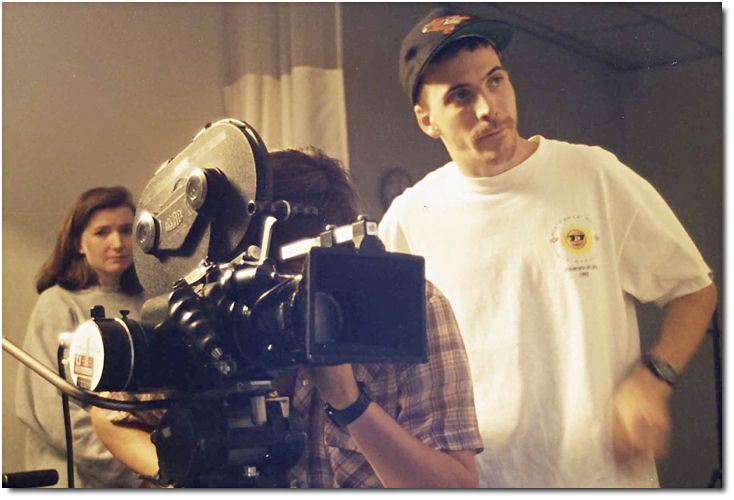 Film School: University of Utah, 1994I am so proud of the fact that I went to the U because I got so much out of film school. I was always the guy who would figure out how to do the extra things – put graphics in for titles, figure out music, props and special FX, just adding extra bells and whistles you typically wouldn’t bring to your student films in those days (again, long before digital and computers).
Film School: University of Utah, 1994I am so proud of the fact that I went to the U because I got so much out of film school. I was always the guy who would figure out how to do the extra things – put graphics in for titles, figure out music, props and special FX, just adding extra bells and whistles you typically wouldn’t bring to your student films in those days (again, long before digital and computers).
Back then, Orson Spencer Hall had this large auditorium where the film history classes were held. We’d watch films on 16mm (eventually we progressed to this new technology called laser disc!). I looked into the department that projected the films, Instructional Media Services out of Milton Bennion Hall, and I went and introduced myself. I asked if I could help project the films and they hired me on staff. So now, I went to classes I wasn’t even enrolled in and projected films. 24/7 film school –– I just absorbed every minute of it.
Countless hours spending all-nighters in editing, living off Mountain Dew and pizza from The Pie. Obsessing over shots and sequences, and trying to find missing frames in the bottom of the bins –– this was our life. Brian Patrick, Kevin Hanson, Dale Elrod, the others, they challenged us to get better at every turn.
I would volunteer to work on everyone’s projects. If I could figure out how to get a moving camera shot, I’d do it. At the time we had this doorway dolly and a wheelchair – you had to get creative. Countless hours spending all-nighters in editing, living off Mountain Dew and pizza from The Pie. Obsessing over shots and sequences, and trying to find missing frames in the bottom of the bins –– this was our life. Brian Patrick, Kevin Hanson, Dale Elrod, the others, they challenged us to get better at every turn. And because I was there all the time, living in the department, and learning as much as I could from my professors and classmates, I got a tremendous education. I treated this like the springboard for me to grow as a filmmaker and prepare me for the future.
Tell us more about your experience at KUED.
Long before the Eccles Broadcast Center was built, KUED was run out of the basement in Gardner Hall in President’s Circle. It was a tiny studio. One of my early work-study jobs was working part-time as a daycare assistant in Research Park. Even there, I was infusing filmmaking into what I was doing, having the kids pretend and act out the stories from the Dr. Seuss books. One of the moms worked at KUED and told me they were looking for interns.
My job was to cut magazine articles for the producer of Civic Dialogue on whatever topic they were covering that week. Ted Capener (Vice President of University Relations at that time) was the host of the show. I couldn’t believe my fortune – working at a TV station, and doing research that actually (possibly) went into the show. I would gladly hang around the studio when they would do the tapings, and I’d watch the camera operators and the activity of the control room. I just started introducing myself to people and finally met the production manager, John Castellano. I expressed my desire to work in the studio and learn camera and lighting, and he snatched me up from cutting the magazine articles. The next thing I knew I was behind a camera with a red tally light coming to life.
I started working on The Coaches Show with Rick Majerus and Coach Mac. Before I knew it, I was floor directing and just learning all I could –– lighting, gripping, tape operating, technical directing, graphics. Later we moved into the (new) Eccles building and it was state-of-the art. We started getting into bigger projects, studio concerts, remote shoots and such. It was an amazing time for me. They all knew of my hopes and dreams to head for Hollywood and encouraged my efforts, including me on whatever I wanted to be involved with. I learned so much with those people at KUED who were kind and generous with their time, and that translated to what I was doing in my classes, and vice-versa.
How did you transition from school into the professional world?
One day in my final year, someone had written on the blackboard a phone message: there was a job opening for an internship –– a TV series shooting in Park City. I took down the number and erased the board. It was super entry level, way down the line, like the producer’s assistant’s assistant’s intern. But I called and said “I’m your guy.” The show was called Extreme for ABC, starring James Brolin, Julie Bowen and others. It was basically Baywatch on snowmobiles. I was running around picking up dry cleaning, restocking snacks in the office, making coffee, answering phones, binding scripts. I was thrilled to be there. I hadn’t officially graduated yet, but I was on my way. 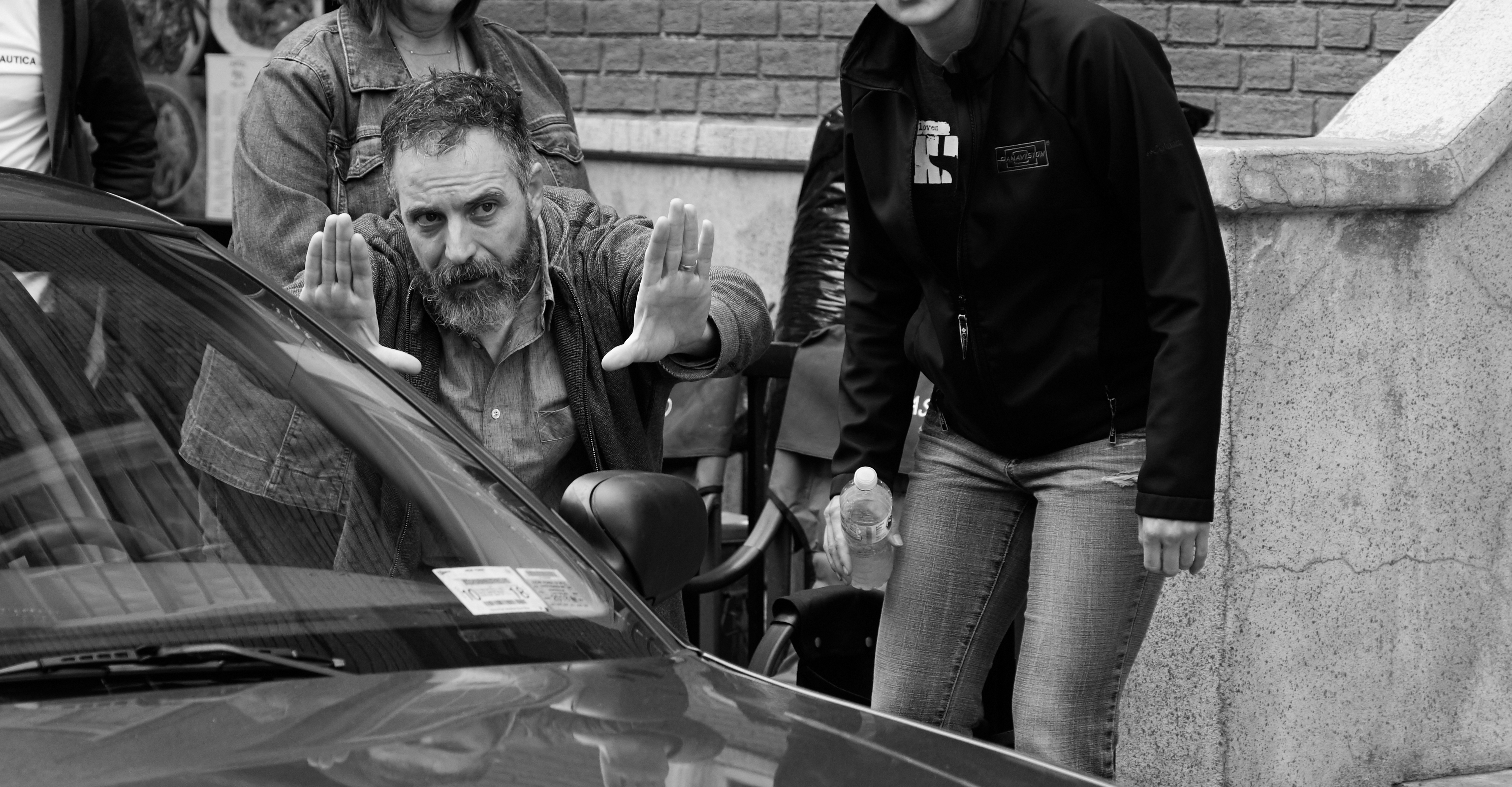 Photo credit: John P. Fleenor | Brooklyn Nine-Nine/NBC Universal
Photo credit: John P. Fleenor | Brooklyn Nine-Nine/NBC Universal
I had been in the production office for about two weeks and really wanted to be on set. The production coordinator said “but you’re so good at this,” and while I appreciated the compliment, I pointed out that if I was getting college credit, and technically paying for said credit, then couldn’t I please go do what I was interested in? She sent me to set as a PA –– I was one step closer. I introduced myself to the camera department. They were breaking for Christmas the next day but invited me to intern with them when production resumed. The first day back I was helping unload the camera truck in three feet of snow, somewhere in Midway. I was ill-prepared with my sneakers and jeans, but it was the greatest thing in the world.
One day in my final year, someone had written on the blackboard a phone message: there was a job opening for an internship –– a TV series shooting in Park City. I took down the number and erased the board. It was super entry level, way down the line, like the producer’s assistant’s assistant’s intern. But I called and said “I’m your guy.”
At the end of three months, working for free, I had formed relationships with a couple of the camera assistants who then brought me onto another job four months later. As I quickly learned, freelance (especially at the start) sometimes means more time off between gigs than not. So while I was figuring out the camera assistant route, KUED’s experience helped me get another job at KUTV, shooting news. I knew I had to be patient and keep trying. It was a matter of putting myself out there – meeting people, being positive, letting people know I was excited and willing to do whatever it took to get the job done. I slowly began to build a network.
When I first moved to Utah, I really thought it was just a stop on the way to LA. I didn’t realize there was already a steady and rather robust film community in Salt Lake with movies, TV series, and commercials. It was the early 90’s and it was thick with production. I found myself in the right place, right time.
So I started to make my mark as a camera assistant. The first half of my career was in Utah. Movies-of-the week, features, commercials, Touched By An Angel for five seasons. Eventually it starts to snowball. I was even traveling around the world on projects. Opportunity can knock every day, but you need to be prepared. If there’s a knock on the door and you’re ready to go, great. If you fumble the ball a couple of times, you might get one or two chances and then you get sent back to the bench. On every job, with every person and every opportunity, I applied myself. I worked hard and kept learning. Attitude was key. If you are dependable and reliable, you may get the job over someone else that has a greater skill set, because people want to be around you 15 hours a day. So it behooves you to care.
What are some of your proudest moments in your career so far?
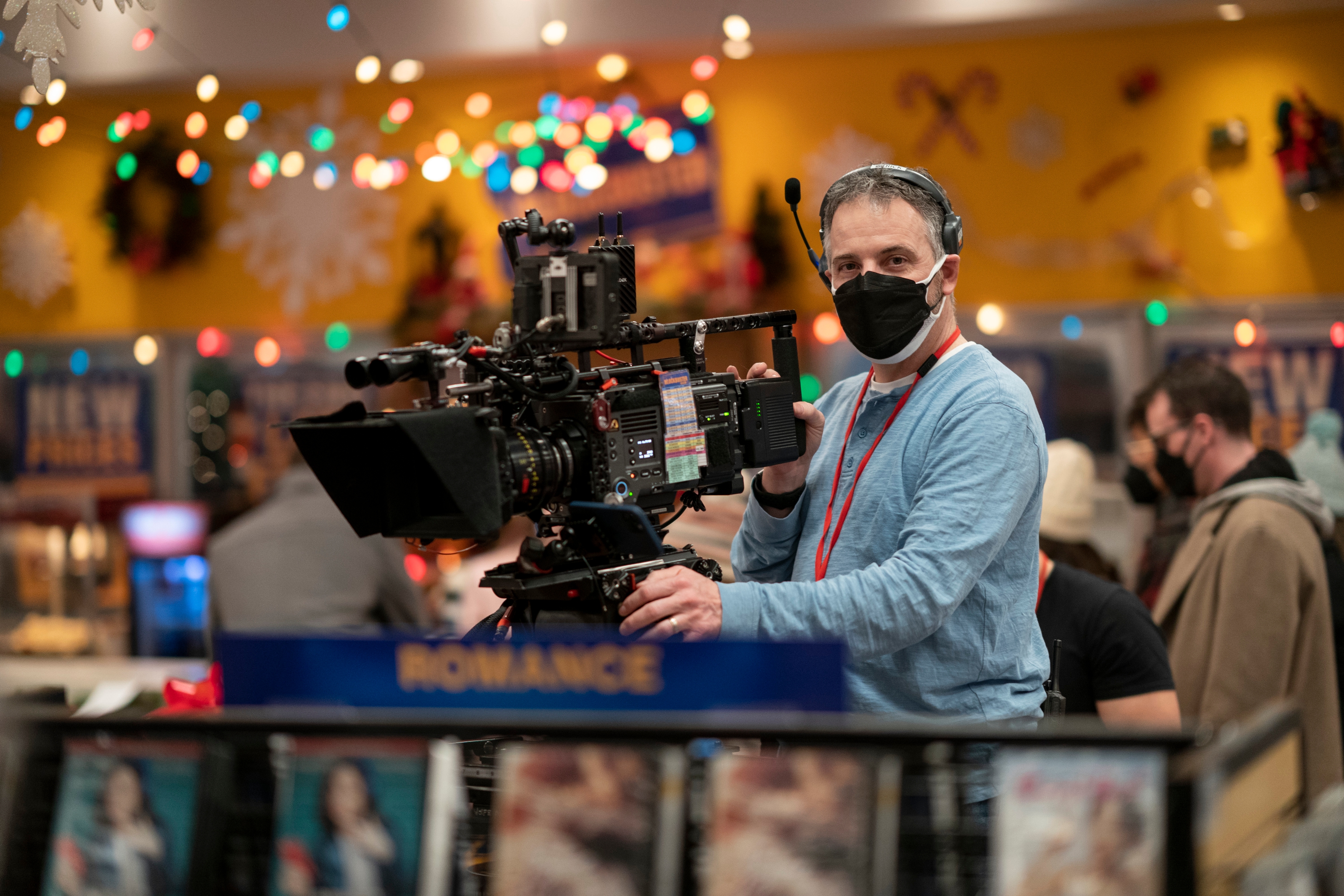 Photo credit: Ricardo Hubbs | Blockbuster/Netflix
Photo credit: Ricardo Hubbs | Blockbuster/Netflix
One is from the finale of season three for Brooklyn Nine-Nine when the showrunner, Dan Goor, was directing. He wanted the last scene of the episode to be a big reveal that the two main characters, Jake and Holt, were now living in Florida. He and the director of photography (DP), who I was operating for, referenced a crane shot from Goodfellas. So we got a Technocrane and designed our version. When you’re operating a shot such as this, you’re directing 4-5 people to work in sync and pull it off. It turned out great (under pressure and all) – the scene played as a oner, and was a fun way to end the season.
Brooklyn Nine-Nine is full of those moments for me. As an operator on that show, I was one (of a select group) who helped form the style of the cinematography that defined the show’s look for eight seasons. I’m incredibly proud of that. During season two in between scenes, I shot a behind-the-scenes featurette with everyone involved. The DP recognized my experience and would push for me to shoot splinter and second units and vouched for me with the producers. I shot a big stunt at Paramount during season three, then bumped up to DP a few episodes for seasons four and five. And then when season six began, the former DP moved on to another opportunity and they promoted me to take over. It was a whole new ball game. I have Matthew Nodella to thank for that. He changed the course of my career.
If I hadn’t done this job and met this person, it wouldn't have led to the next thing. It’s a complex tapestry that you can’t really plan.
I had always sort of felt that I would be a director – and then growing up in cinematography inspired me in new and exciting ways. It’s incredibly collaborative and constantly challenging. In television, directors come and go. But as a DP, you shoot every scene, every episode. You’re working with the crew, cast, writers, and producers all season long. These other shows I have been working on recently –– Grand Crew, Blockbuster, Sex Lives of College Girls –– I love helping design the looks and styles of these shows, helping to craft these stories and work closely with the showrunners, producers, and directors. My appreciation never fades because I get to be creative. I’m part of the team. I feel included. That was something I appreciated way back with my high school buddies, and later with KUED, and my class in film school –– these people included me. The instructors at the U would allow (and encourage) me to do all these extra things and that kept re-igniting my passion and desire to go after it.
I have often thought about this when I’m reflecting on the road map of my life. If I hadn’t done this job and met this person, it wouldn't have led to the next thing. It’s a complex tapestry that you can’t really plan. I worked for and assisted some ACs back in Utah that hired me on jobs where I learned from some really great DPs. And those DPs inspired me and brought me along where I met other people, which lead to other projects. It’s how it works, really. On Brooklyn Nine-Nine, multiple writers have gone on to great success, creating and running their own shows –– three of which I’ve had the honor of working for. These opportunities come from working hard and fostering solid relationships. That’s why you give 200% on everything you do. You never know who you’re going to run into and maybe work for (or with) later in life.
What was most surprising to you about the realities of working on television and film sets?
When I first showed up on set, I was thrilled to be there – the lights, the cameras, the sets. Actors walking around, free food. I discovered that a lot of people did not share this feeling. Not everyone walks around overjoyed that you’re on the same stage where Jimmy Stewart acted in 1953. That surprised me – but the fact is, for some it’s just a job, a way to earn a paycheck. And that’s okay. But for me when you love what you do, it’s not a job, it’s a way to live. I feel a sense of gratitude every time my badge opens the gate at the studios. It’s like, “Look at that, I made it another day.” I work 200 feet from Spielberg’s office… I mean, come on!
The production schedule can be grueling on any given project. It requires mental and physical preparedness. You work out, eat right, you meditate, you have a therapist. Keep your head above water. Learn everyone’s position. Keep your eyes and ears open. Grow a thick skin.
I feel a sense of gratitude every time my badge opens the gate at the studios. It’s like, “Look at that, I made it another day.” I work 200 feet from Spielberg’s office… I mean, come on!
There are plenty of people who feel like they paid their dues and learned the hard way and are just there to do the job. But I subscribe to the idea of paying it back (and paying it forward). I check in with my mentors (the ones who are still around) from time to time, let them know what I’m up to and how I’m trying to do what they taught me.
I had the great fortune once of directing a short film with the legendary actor, Ossie Davis. I was collaborating with some crew from Touched By An Angel and we had pooled together our resources to make this little film.
Ossie was 80 years old at the time. I was a kid. He’d agreed to work with us for a day and we flew him out to Salt Lake from New York. Before we rolled the first shot, I asked him why he was helping us. He said, “Young man, when I was your age and coming up, there were those who helped me along who are now no longer with us. This is how you pay them back, by helping the younger generation to come along.” I try every day to live by Ossie’s generosity.
One more story that takes the cake
When I was in film school at the U, actor/director Robby Benson was an adjunct professor who would visit once or twice a year for guest lectures. He and Brian Patrick arranged a field trip to LA to see a taping for a show Robby was directing called Evening Shade. We got to tour Panavision and some film labs, Disney animation –– it was inspiring as students to see how some of the business works and be around the professionals.
And then we went over to CBS Radford Studios, which is one of the oldest lots in Hollywood, built in 1928. Mack Sennett studios. It later became Republic Pictures where actors like John Wayne, Gene Autry, Roy Rogers started their careers. John Ford shot parts of The Quiet Man there, Gunsmoke was there, later on Gilligan’s Island, eventually Newhart, The Mary Tyler Moore Show. In the 90s, Seinfeld. A wealth of TV history in this place.
Stage 15: it was the first time I ever saw a soundstage. Burt Reynolds walked by and said hello. There was (the first time I’d met him) Ossie Davis, and Michael Jeter, and Charles Durning. Marilu Henner. This was a crazy front row seat –– no audience –– just us students watching the crew block camera rehearsal with the actors. And I met the DP, Nick McLean.
I remember walking outside of the stage doors and seeing the other soundstages across the way. I watched grips pushing dollies around, electricians moving lights, wardrobe racks rolling by, forklifts moving set pieces, and golf carts driving past –– all this studio-lot activity. I thought to myself, “I have to be here. How will I get to do this?” It seemed so far away.
I kept in touch with that DP for a couple years as I was getting into the business, mid-90s. Nick invited me to come by anytime I was in LA, which I happily took him up on. I’d go to CBS Radford and over to Stage 15 to watch whatever was going on with Evening Shade and then later a show called Cybill. Hoping to meet people.
Nick McLean put my eye behind a lens for the very first time, a 14mm on a Panaflex. I’d talk to the camera operators, the dolly grips. Then I’d go wander and watch rehearsals of Seinfeld. I’d just explore the lot and soak it all in.
In 2013, I get hired on a new show called Brooklyn Nine-Nine that was set to shoot at CBS Radford. Now I have a badge. The gate goes up. We are shooting on Stage 12, kitty-corner to Stage 15. It had happened.
Cut to 2021, eight years later. 153 episodes. I’m the DP of that same show. We’d been though eight seasons together –– me and hundreds of others. The series had been cancelled and picked up again. We’d witnessed marriages and divorces, births and deaths. People came and people went. Covid and the year of the pandemic. Bonds of friendship. We went through a lot of life together by the end, which is a rare thing in this business. This was a journey for the books.
I saw the ghost of my former self almost 30 years earlier, that kid from the U, so curious, so hopeful, so determined yet uncertain how it would all happen.
When we shot the series finale, with an amazing gesture, the producers gave me a cameo role in the show with the entire cast in the last scene. What’s more, our producer (Matt Nodella) came up to me before the last day and said “Tomorrow when we wrap, we’re going to empty the stage, and we want only three people to give speeches to everyone. It’ll be Andy (Samberg), Dan (our showrunner) and you. You’ll lead us off.” I only had that night to prepare.
As I spoke the next day, gazing at this massive group of tearful friends and co-workers, I looked over and noticed those doors on Stage 15, just about 100 feet away. I saw the ghost of my former self almost 30 years earlier, that kid from the U, so curious, so hopeful, so determined yet uncertain how it would all happen. What a privilege.
For more:
rickpagedp.com | IG: RickPage_

